2019初二上册第五课中国山水画教育英语
八年级英语(人教版)上册精细课件-【第5课时(Section B 3a-Self Check)】

down the invitation, give a good reason.
Include the following information:
*kind of party or event *when and where it will be *if guests should bring anything *if guests should reply to the invitation *when and how guests should reply
谢绝邀请的回信一般包含以下几方面的内容: 首先还是要对对方的邀请表示感谢; 然后具体 说明自己无法接受邀请的原因,并对无法出席 表示遗憾; 最后表达自己的祝愿,即祝愿自己 未能参加的会议或者活动能够顺利进行。
Write an invitation to a party or any other
3b event. Reply to your partner’s invitation. If you turn
Yes, they do. Each of them has to bring one book as a gift.
6. How should people reply to this invitation, and when? They should reply in writing to this invitation by Friday, December 20th.
中国水墨画英语作文六年级 中英文
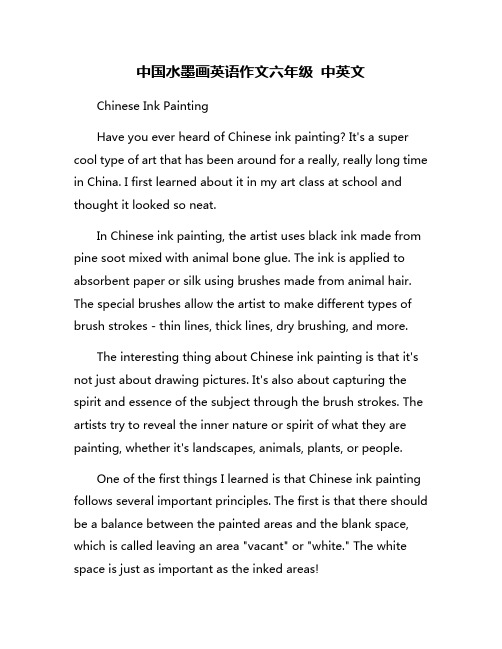
中国水墨画英语作文六年级中英文Chinese Ink PaintingHave you ever heard of Chinese ink painting? It's a super cool type of art that has been around for a really, really long time in China. I first learned about it in my art class at school and thought it looked so neat.In Chinese ink painting, the artist uses black ink made from pine soot mixed with animal bone glue. The ink is applied to absorbent paper or silk using brushes made from animal hair. The special brushes allow the artist to make different types of brush strokes - thin lines, thick lines, dry brushing, and more.The interesting thing about Chinese ink painting is that it's not just about drawing pictures. It's also about capturing the spirit and essence of the subject through the brush strokes. The artists try to reveal the inner nature or spirit of what they are painting, whether it's landscapes, animals, plants, or people.One of the first things I learned is that Chinese ink painting follows several important principles. The first is that there should be a balance between the painted areas and the blank space, which is called leaving an area "vacant" or "white." The white space is just as important as the inked areas!另一个原则是"写意"(xiěyì),大概可以翻译为"捕捉本质"。
中国水墨画英语作文六年级 中英文
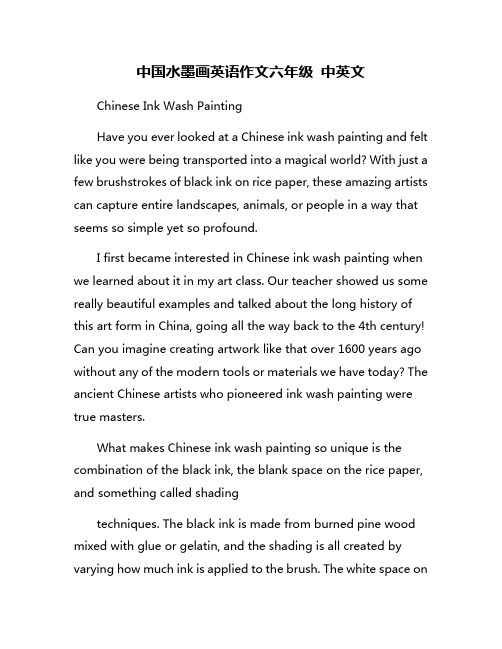
中国水墨画英语作文六年级中英文Chinese Ink Wash PaintingHave you ever looked at a Chinese ink wash painting and felt like you were being transported into a magical world? With just a few brushstrokes of black ink on rice paper, these amazing artists can capture entire landscapes, animals, or people in a way that seems so simple yet so profound.I first became interested in Chinese ink wash painting when we learned about it in my art class. Our teacher showed us some really beautiful examples and talked about the long history of this art form in China, going all the way back to the 4th century! Can you imagine creating artwork like that over 1600 years ago without any of the modern tools or materials we have today? The ancient Chinese artists who pioneered ink wash painting were true masters.What makes Chinese ink wash painting so unique is the combination of the black ink, the blank space on the rice paper, and something called shadingtechniques. The black ink is made from burned pine wood mixed with glue or gelatin, and the shading is all created by varying how much ink is applied to the brush. The white space onthe rice paper is just as important as the inked areas in creating the overall composition.One of the first things I learned is that there are actually a few different styles within the genre of Chinese ink wash painting. The most famous ones are:Gong Bi - This means "meticulous" and involves very precise, detailed brushwork to capture things like the scales on a fish extremely accurately.Xie Yi - The opposite of Gong Bi, Xie Yi means "freehand" and uses more expressive, loose brushstrokes to convey the spirit or essence of the subject.Zhi Gong - This style combines the fine details of Gong Bi with the freedom of Xie Yi to depict plants, animals, landscapes or figures.Mo Gu - Focuses specifically on painting different types of trees, plants and flowers using shaded ink wash techniques.Each style allows the artist to express different emotions, moods and creative visions through their brushwork. To me, that's what makes Chinese ink wash paintings so magical - the same bamboo branch, for example, could look completely different when rendered by artists using contrasting styles likeGong Bi versus Xie Yi. It shows how the spirit and creativity of the individual painter is such an integral part of this art form.While the different styles are incredible, I think my favorite element of Chinese ink wash painting has to be the symbolism. Certain plants, animals, or objects were used to represent different life concepts or virtues like strength, perseverance, beauty, or longevity. For example:• Bamboo = Resilience, longevity• Plum blossoms = Perseverance, hope• Chrysanthemums = Longevity• Orchids = Refinement, innocence• Lotus = Purity• B irds = Freedom, dignity• Fish = Abundance• Mountains = Stability, strength• Water = Harmony, peaceLearning about the deeper meanings behind the subjects makes appreciating these paintings even more profound. It's like they are visual poems celebrating the wonders of nature and thevirtues that the ancient Chinese philosophers felt were most essential to cultivate.Of course, no essay on Chinese ink wash painting would be complete without mentioning the Four Gentlemen. No, I'm not talking about fancy rich guys - the Four Gentlemen are actually the bamboo plant, the orchid, the plum blossom, and the chrysanthemum! These four were considered the most noble plants in Chinese culture and they were common subjects that ink wash painters loved to depict, especially early on before the different styles emerged.As I mentioned, bamboo symbolizes resilience since it's a very hardy, flexible plant. The orchid represents refinement and innocence. The plum blossom is admired for its perseverance in blooming during the harsh winters. And the chrysanthemum is celebrated for its longevity since it blooms so vibrantly in the autumn towards the end of the season. Together, the Four Gentlemen perfectly embody the most prized virtues in traditional Chinese culture.In my art classes, we've gotten to try our own hand at Chinese ink wash painting which is definitely not as easy as it looks! The fluid brushstrokes required to capture the spirit and essence of a subject take a lot of skill and practice to master. Westarted by just doing basic ink wash exercises with different brushstrokes and shading techniques before moving on to simple subjects like bamboo leaves or plum branches.Even those basic sessions taught me how much focus, patience, and attention to detail is required in this artform. You have to envision the entire painting in your mind first, then concentrate intently as you lay down each individual brushstroke to gradually build up the image you see in your head. It's almost like a meditation.The tools are pretty fascinating too. Of course you need brushes made from animal hair, an ink stone to grind the solid ink stick into liquid ink, and xuan paper which is made from rice plants. But Chinese artists also use these cool reservoirs made of bamboo, ceramic or stone to hold the liquid ink near their work surface. And get this - some brushes can cost thousands of dollars if they are made from really premium materials! Yikes, you'd better be an ink wash master to handle brushes that expensive.I have so much respect and admiration for the ancient and modern Chinese ink wash painters who have elevated this art form over the centuries. It takes incredible technical skill, focus, and creativity to produce those amazingly vivid yet deceptivelysimple-looking paintings. To me, any artist who can capture so much life, energy and symbolic meaning through just a few brushstrokes of black ink is a true master.While some people might just see blobs of black on paper, Chinese ink wash paintings represent a deep connection to nature, philosophy, and the human experience when you learn to read the hidden meanings and stories behind them. They remind us to appreciate the beauty in simplicity, to find inspiration all around us in the natural world, and to strive towards cultivating virtues that lead to harmony - both within ourselves and in the universe.For such an ancient artform, Chinese ink wash painting has certainly evolved over the centuries as different styles emerged. But its core spirit of distilling the essence of a subject, revealing the beauty of blank space, and using symbolism to convey profound meanings has remained a constant. To me, that's true magic.中文翻译:中国水墨画你有没有观赏过中国水墨画,感觉仿佛置身于一个神奇的世界?凭借一些黑色墨水在宣纸上的几笔画,这些了不起的艺术家就能捕捉到整个景观、动物或人物,给人一种简单而又深刻的感觉。
2019年初二上美术知识要点知识总结《自然意趣,中国山水画》

清朝四王
画坛的正统派,即王时敏、王鉴、王翚、王原祁。共同特点:他们在艺
术上强调“日西临摹”、“宛然古人”,脱离现实醉心于前人笔墨技巧的
路线,摹古画是他们山水画创作的一大倾向。
画家姓名 范宽 倪瓒 米友仁 李可染
作品名称 《溪山行旅图》 《容膝斋图》 《云山墨戏图》 《万山红遍》
写景 黑山白水 青山秀水 云山雾水 红山赤水
2
画作名称 《鹊华秋色图》
《清凉环翠图》
作者 赵孟頫
龚贤
朝代 要点 元代 书法与欧阳询、柳公权、颜真卿并称四大体“赵体、
欧体、柳体、颜体”。 表现了秋天景色,右边有尖顶的是华不注山,左边呈 浑圆状者是鹊山。乾隆皇帝的心爱之宝,乾隆亲笔" 鹊华秋色"大字题写于引首,并题跋九则,钤印众多。 清代 龚贤、樊圻、吴宏、邹喆、谢荪、叶欣、高芩、胡慥 等几位南京画家,被称为“金陵八家”
代表作品 《溪山行旅图》 《山径春行》 《临溪抚琴图》 《云山墨戏图》 《容膝斋图》 《富春山居图》 《鹊华秋色图》 《真赏斋图》 《清凉环翠图》 《淮扬洁秋图》 《江山如此多娇》 《青城山》
5
李昭道,并称“二李”,是“是青绿山水”的集大成
者。
《游春图》 《溪山行旅世最早的一件山水画卷。“咫尺千里”,是山水 画逐步走向成熟的标志 作品以春游为主题,青山、 江流、人物、佛寺点缀其间生动描写了许多士人在山 水中纵情游乐的情景。展子虔开创了中国山水画一种 独具风格的画法-----青绿山水。
1
画作名称
作者
《临流赋琴图》 夏圭
朝代 要点 南宋 夏半边,一改五代北宋以来上留天、下留地、正面默
写的全景式构图,将景物集中于一侧,表现浩淼的空 间。
《山径春行》 《容膝斋图》
中国水墨画英文介绍教学内容

中国水墨画英文介绍Chinese painting as one of Chinese traditional art forms, coming from Chinese calligraphy, is a bridge to show Chinese people’s value in life and nature, individual and collective, internality and externalism. It is subjectively expressing people’s inner reaction towards the whole society. Conventionally, China’s painting is directly connecting with calligraphy. They are integrative. In Chinese people’s thinking, a traditional poet should be of the capability of painting, calligraphy, poem and music. So as one of the basic skills to be an eligible literator, the skill of painting is indeed important.The painting is the outside expression of the poem content and the image of calligraphy, and it is also the exterior show of people’s inner world. The poem is painting and painting is poem as well. Additionally, many people’s personal ambition or lifelong aim can not be realized by the earthly work, and then the paint their ideal world into their painting. This is one of the origins of Chinese unique painting school, which is literary-painter school. This is a special one only existing in China. Through this artistic form, many expressions on culture could be felt.In general, China’s painting was flowering after Han Dynasty.During the time of three kingdoms and the period of Wei and Jin Dynasties, it was a process from unification to separation. The instability of politics, the turbulence of society and depression of economy bought the unusual change in ideology. At this time, the ruling class was thoroughly influenced by the Confucianism and the folk ethos was also changed as it went. The troublous society made a good opportunity for religion spread. The urgent demand and extensive acceptance of all walks of life to Buddhism were available. The character painting extremely expanded and developed instantly. Most of the paintings are concerned about the Buddhism and the stories related. In Tang Dynasty, due to the freedom of religion-believing, the Buddhism painting extremely expanded, including most of China’s world-renowned frescos. The most typical and outstanding representative painter in this period was Wu Daozi, who was famous for his character paintings (religion paintings) and paintings on mountains and waters.In Song and Ming Dynasties, it was the golden time for Chinese paintings. As the flourish of the literature, the painting was also widely welcomed in public. The greatest masters in Song and Ming Dynasties mostly were good at the painting with high-level image. Nowadays it is valued too much! Many schools of paintings were in these periods. Especially in Song Dynasty, there was a very outstanding Emperor was excellent in painting and calligraphy. He created his own painting style and founded the rare royal painting school. However he was not advisable and welcome in politics as an Emperor. In Ming Dynasty, there were also more great painters meanwhile the excellent literators who were tragically failing in royal examination. In China, if you want to understand the painting, you will be learning a little bit about the traditional poem, calligraphy and the exams. Besides, you also should know the general list of Chinese history.The painting above is one of China top-ten classic paintings in Chinese ancient days. it is the masterpiece of great painter, Gu Kaizhi, the painter lived in East Jin Dynasty. This long painting is named Luoshenfutu. It is focusing on the goddess of Luo River with the hisotry of more than 1600 years.^ top ^This is the masterpiece created by Wu Daozi who was the great master in Tang Dynasty. He was good at the painting of buddhisitic stories or fairtales. Besides he also did well in emperor painting. He was an outstanding painting on religion. His name is also associated with Taoism. This painting is Tianwangsozitu.This is the masterpiece of Zhan Zixu, another great master of painting in Tang Dynasty. It is also one of China's classic painting of old days . it is focusng on the landscape of their travel destination, when they were visiting in Spring.^ top ^This is a rare painting created by oneemperor of Song Dynasty.This is another classic painting of SongDynasty.It is highlighted for its historical importance. Painting in Song Dynasty was emphasized incomparably, because the emperor loved painting very much.^ top ^The paintings above are the most famous one in China's history. Currently it is the national treasure. It was created in Song Dynasty. The painter was Zhang Zeduan. It was the first painting to depict the daily life of commoners in Bianliang, the capital of Song Dynasty . It shows the prosperity of economy at that time.^ top ^These two painting are focusing on the landscape of nature meanwhile also mixed with some painters imagination on thir ideal image. there were both created in Song Dynasty.The pictures above all created by the literator in Ming Dynasty. Actually it was a progressive way from Tang Dynasty to Song Dynasty.^top^The paintings above generally inherited the traditional features of Ming Dynasty. It is diversified and colorful!Since Song Dynasty, Chinese culturevividly revealed in the aspect of painting inclined to the elite culture or the elegant literator's taste. These paintings were unprecedentedly popularized in Ming and Qing Dynasties. It was a fashion in pursuit of self-improvementThe paintings above were all created by modern Chinese painters. They are theauthorized representatives of the modern Chinese painting and the leaders of China's art.。
中国山水画历史英文作文
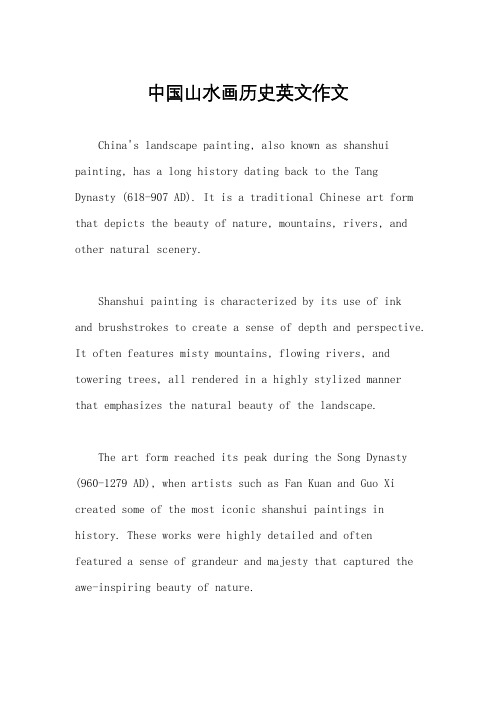
中国山水画历史英文作文China's landscape painting, also known as shanshui painting, has a long history dating back to the TangDynasty (618-907 AD). It is a traditional Chinese art form that depicts the beauty of nature, mountains, rivers, and other natural scenery.Shanshui painting is characterized by its use of inkand brushstrokes to create a sense of depth and perspective. It often features misty mountains, flowing rivers, and towering trees, all rendered in a highly stylized mannerthat emphasizes the natural beauty of the landscape.The art form reached its peak during the Song Dynasty (960-1279 AD), when artists such as Fan Kuan and Guo Xi created some of the most iconic shanshui paintings in history. These works were highly detailed and oftenfeatured a sense of grandeur and majesty that captured the awe-inspiring beauty of nature.During the Ming Dynasty (1368-1644 AD), shanshui painting continued to evolve, with artists such as Shen Zhou and Wen Zhengming incorporating more expressive brushstrokes and a greater sense of individuality intotheir work. This period also saw the rise of literati painting, which emphasized the artist's personal expression and feelings.In the modern era, shanshui painting has continued to thrive, with artists such as Wu Guanzhong and Huang Binhong bringing new techniques and styles to the art form. Today, shanshui painting remains an important part of Chinese culture, reflecting the country's deep connection to its natural environment and its rich artistic heritage.。
中国书画(英文版)
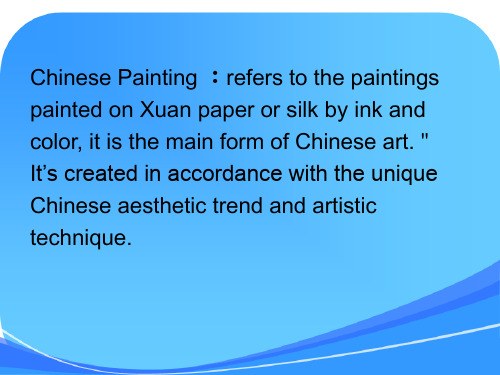
Freehand style(写意画) Fine-brush (工笔画)
Classification:
Relationship with calligraphy(书法):
Calligraphy is the leader of all art forms.Chinese painting and calligraphy has the same origin.They are the the spirit of Chinese culture and belong to the same family. A lot of big great calligraphers are great painters. So there is a saying that “painting and calligraphy are not separated”(书画不分家).
Wu Daozi (吴道子,AD. 680~759years):
the greatest painter in history, also a calligrapher.
Mi Fu (米芾,1051-1107 years)
蜀素帖 春山瑞松园
Zhao Ji (宋徽宗赵佶,AD.1082~1135 years)
Thank You !
A emperor of Song dynasty
Zhao Mengfu (赵孟頫,1254—1322 years)
洛神赋 重江叠嶂图卷
Qi Gong (启功,1912—2005 years)
Luo Shenfu(Gu Kaizhi)
清明上河图(张择端)
王希孟《千里江山图》
The Calligraphy:
中国传统文化中国画英文PPT课件
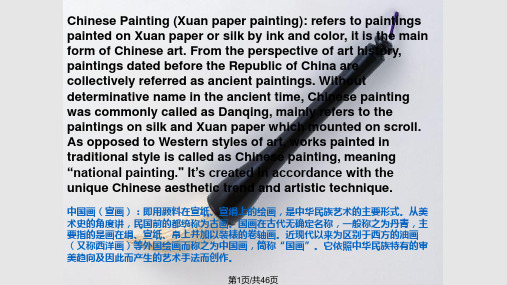
Chinese Bird-and-flower paintin第g 19页/共46页
第20页/共46页
Chinese Figure Painting
Classification according to the
technique of Chinese painting 中国画按技法划分
great freehand style大写意
第35页/共46页
第36页/共46页
第37页/共46页
第38页/共46页
第39页/共46页
Bamboo
第40页/共46页
• WWD
Paint the bamboo poles first..
第41页/共46页
Before the ink becomes dry, add the twigs and leaves.
第33页/共46页
• 1.Hold the brush handle upright and the brush tip will move right. • 笔正:笔正则锋正。 • 2.Keep the fingers firm with flexibility. • 指实:要劳实有力,还要灵活不死。 • 3.keep the palm relaxed and empty . • 掌虚:不要紧握,掌心是空的。 • 4.lift the wrist and elbow above the table to use the brush freely。 • 运笔要悬肘。
中国画(宣画):即用颜料在宣纸、宣绢上的绘画,是中华民族艺术的主要形式。从美 术史的角度讲,民国前的都统称为古画。国画在古代无确定名称,一般称之为丹青,主 要指的是画在绢、宣纸、帛上并加以装裱的卷轴画。近现代以来为区别于西方的油画 (又称西洋画)等外国绘画而称之为中国画,简称“国画”。它依照中华民族特有的审 美趋向及因此而产生的艺术手法而创作。
介绍中国山水画的英语作文
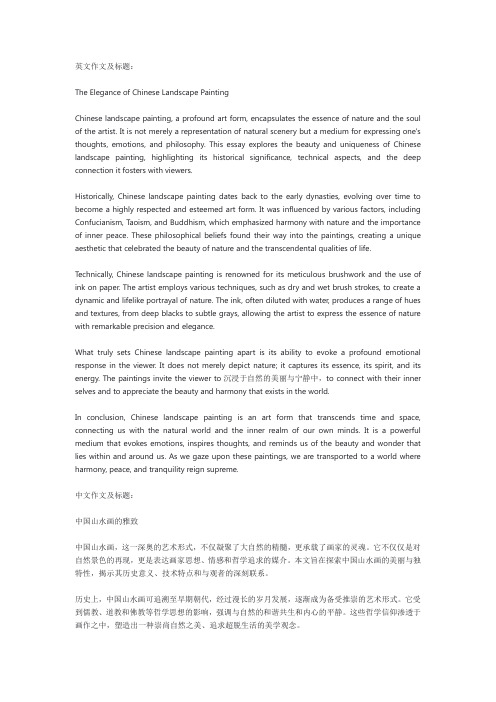
英文作文及标题:The Elegance of Chinese Landscape PaintingChinese landscape painting, a profound art form, encapsulates the essence of nature and the soul of the artist. It is not merely a representation of natural scenery but a medium for expressing one's thoughts, emotions, and philosophy. This essay explores the beauty and uniqueness of Chinese landscape painting, highlighting its historical significance, technical aspects, and the deep connection it fosters with viewers.Historically, Chinese landscape painting dates back to the early dynasties, evolving over time to become a highly respected and esteemed art form. It was influenced by various factors, including Confucianism, Taoism, and Buddhism, which emphasized harmony with nature and the importance of inner peace. These philosophical beliefs found their way into the paintings, creating a unique aesthetic that celebrated the beauty of nature and the transcendental qualities of life.Technically, Chinese landscape painting is renowned for its meticulous brushwork and the use of ink on paper. The artist employs various techniques, such as dry and wet brush strokes, to create a dynamic and lifelike portrayal of nature. The ink, often diluted with water, produces a range of hues and textures, from deep blacks to subtle grays, allowing the artist to express the essence of nature with remarkable precision and elegance.What truly sets Chinese landscape painting apart is its ability to evoke a profound emotional response in the viewer. It does not merely depict nature; it captures its essence, its spirit, and its energy. The paintings invite the viewer to沉浸于自然的美丽与宁静中,to connect with their inner selves and to appreciate the beauty and harmony that exists in the world.In conclusion, Chinese landscape painting is an art form that transcends time and space, connecting us with the natural world and the inner realm of our own minds. It is a powerful medium that evokes emotions, inspires thoughts, and reminds us of the beauty and wonder that lies within and around us. As we gaze upon these paintings, we are transported to a world where harmony, peace, and tranquility reign supreme.中文作文及标题:中国山水画的雅致中国山水画,这一深奥的艺术形式,不仅凝聚了大自然的精髓,更承载了画家的灵魂。
国画英文介绍详细ppt说课讲解

Division and Planning
经营位置
Transmission by Copying 折叠传移摸写
EXECUTE DESIGN
six 锐 精
于 某 件
普 事
的 唯 一
principles 演 途 径 就 是 示 你 真 心 的 (六原则) 设 热 爱 它 , 计 你 最 终 会 成 为 这 一 行 的 大 师
3.“Correspondence to the Object”, 应物象形是也 or the depicting(描述) of form, which would include shape and line.
适合
4.“Suitability to Type”, 随类赋彩是也 or the application of color, including layers, value, and tone (色泽). 是指画家的描绘要与所反映的对象形似,包括层次,价值和色调。
4.six principles 5. The difference between Chinese painting and Western painting
1 Introduction
Chinese painting is one of the oldest continuous artistic (艺术的) traditions in the world. Painting in the traditional style is known today in Chinese as guó huà, as opposed to Western styles of art which became popular in China in the 20th century.
中国山水画的英语
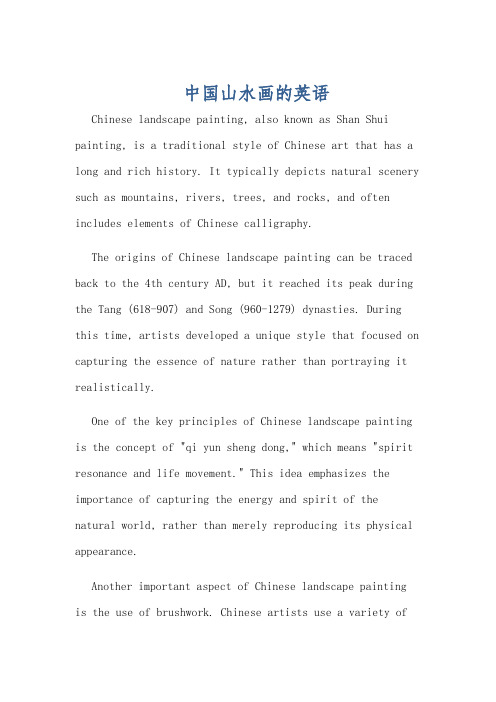
中国山水画的英语Chinese landscape painting, also known as Shan Shui painting, is a traditional style of Chinese art that has a long and rich history. It typically depicts natural scenery such as mountains, rivers, trees, and rocks, and often includes elements of Chinese calligraphy.The origins of Chinese landscape painting can be traced back to the 4th century AD, but it reached its peak during the Tang (618-907) and Song (960-1279) dynasties. During this time, artists developed a unique style that focused on capturing the essence of nature rather than portraying it realistically.One of the key principles of Chinese landscape painting is the concept of "qi yun sheng dong," which means "spirit resonance and life movement." This idea emphasizes the importance of capturing the energy and spirit of the natural world, rather than merely reproducing its physical appearance.Another important aspect of Chinese landscape paintingis the use of brushwork. Chinese artists use a variety ofbrush techniques to create different textures and effects, such as "cun fa" (layering strokes) and "xie yi" (sketching with a free hand). These techniques allow artists toexpress their emotions and feelings through their work.In addition to mountains and rivers, Chinese landscape painting often includes other elements such as trees, rocks, and pavilions. These elements are carefully arranged to create a sense of balance and harmony within the composition.Chinese landscape painting has had a significantinfluence on Western art, particularly during the 19th and 20th centuries. Artists such as Claude Monet and Paul Cézanne were inspired by the simplicity and elegance of Chinese landscape painting, and incorporated some of its techniques into their own work.Overall, Chinese landscape painting is a unique and timeless art form that continues to inspire artists and art lovers around the world.中国山水画,又称山水画,是中国传统艺术的一种,具有悠久而丰富的历史。
关于中国山水画展览的英文作文
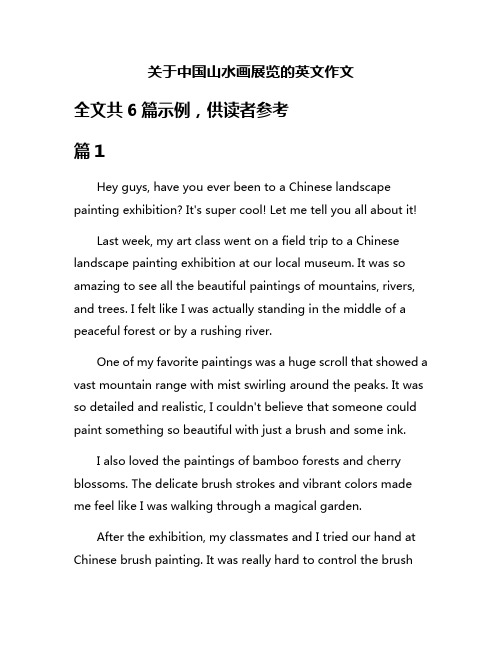
关于中国山水画展览的英文作文全文共6篇示例,供读者参考篇1Hey guys, have you ever been to a Chinese landscape painting exhibition? It's super cool! Let me tell you all about it!Last week, my art class went on a field trip to a Chinese landscape painting exhibition at our local museum. It was so amazing to see all the beautiful paintings of mountains, rivers, and trees. I felt like I was actually standing in the middle of a peaceful forest or by a rushing river.One of my favorite paintings was a huge scroll that showed a vast mountain range with mist swirling around the peaks. It was so detailed and realistic, I couldn't believe that someone could paint something so beautiful with just a brush and some ink.I also loved the paintings of bamboo forests and cherry blossoms. The delicate brush strokes and vibrant colors made me feel like I was walking through a magical garden.After the exhibition, my classmates and I tried our hand at Chinese brush painting. It was really hard to control the brushand make the right strokes, but it was so much fun to create our own mini masterpieces.I learned so much about Chinese art and culture from this exhibition. I can't wait to go back and see more amazing paintings in the future. If you ever get the chance to visit a Chinese landscape painting exhibition, don't miss it! It's an experience you won't forget.篇2Once upon a time, there was a super duper cool art exhibition all about Chinese landscape paintings. It was like walking into a magical world filled with mountains, rivers, and trees all painted on paper!The paintings were soooooo amazing, you could almost feel the breeze blowing through the mountains and hear the water flowing in the rivers. Some of the artists even used special techniques to make the mountains look misty and distant, like they were floating in the air.One of my favorite paintings was of a tiny little boat on a big, big river. The artist used shades of blue and green to make the water look so realistic, I wanted to jump right into the painting and go for a ride in that boat!And the best part was, the artists didn't just paint the landscape, they also added little people and animals to make the scenes come to life. There were farmers working in the fields, birds flying in the sky, and even a little monkey swinging from a tree.I learned so much from the exhibition about Chinese culture and history. I never knew that the Chinese loved nature so much and that they used paintings to capture the beauty of their land.If you ever get a chance to visit a Chinese landscape painting exhibition, don't miss it! It's like taking a trip to a magical world full of mountains, rivers, and forests. You'll be amazed at how talented the artists are and how they can make a simple piece of paper come alive with color and beauty.篇3Once upon a time, I went to a Chinese landscape painting exhibition with my family. It was so cool to see all the beautiful paintings of mountains, rivers, and trees. The artists must have worked so hard to make them look so real!The paintings were really big, and some of them even looked like they were glowing in the dark. It was like we were actually in the mountains, breathing in the fresh air and feeling the coolbreeze on our faces. I could almost hear the trickling of the rivers and the chirping of the birds.My favorite painting was one of a big mountain with a waterfall cascading down the side. It was so detailed, with every rock and tree painted so perfectly. I could even see little fish swimming in the water! It made me feel like I was on an adventure, climbing to the top of the mountain and exploring the hidden caves behind the waterfall.I also liked a painting of a peaceful lake with lotus flowers floating on the surface. The colors were so pretty, with shades of pink, green, and blue blending together like a beautiful rainbow.I wished I could jump right into the painting and splash around in the water, picking the lotus flowers and making a pretty crown for myself.After looking at all the paintings, I felt so inspired to try painting my own Chinese landscape. I grabbed some paper and paints when I got home, and started creating my own masterpiece. It was so much fun, and even though it didn't look as amazing as the ones in the exhibition, I was proud of my artwork.The Chinese landscape painting exhibition was truly an unforgettable experience for me. I learned so much about artand culture, and I can't wait to visit more exhibitions in the future. Who knows, maybe one day I'll be a famous artist too!篇4Title: My Visit to a Chinese Landscape Painting ExhibitionHello everyone! Today I want to tell you all about a super cool adventure I had at a Chinese landscape painting exhibition. It was so amazing and I learned a lot of new things!First of all, let me tell you what a landscape painting is. It's like a picture of a beautiful outdoor scene, with mountains, rivers, trees, and all kinds of natural things. Chinese landscape paintings are super famous because they are just so pretty and peaceful.When I got to the exhibition, the first thing I noticed was how big and detailed all the paintings were. The artists must have worked really hard to make them look so lifelike. Some of the paintings were of huge mountains covered in mist, while others showed calm rivers flowing through forests. It was like stepping into a whole new world!One thing I learned at the exhibition is that Chinese landscape paintings often have a lot of symbolism. For example, mountains can represent strength and stability, while rivers cansymbolize the flow of life. It was really interesting to learn about all the different meanings behind the paintings.I also got to try my hand at painting my own little landscape picture at the exhibition. It was so much fun to use the brushes and paints, even though my painting didn't turn out quite as good as the ones in the exhibition!Overall, my visit to the Chinese landscape painting exhibition was a fantastic experience. I learned a lot, saw some beautiful art, and even got to try painting myself. I can't wait to go back and see more amazing paintings in the future!That's all for now, thanks for listening to my story! Bye bye!篇5One day, my art class went on a field trip to a Chinese landscape painting exhibition. It was super cool!When we walked into the exhibition hall, the first thing we saw was a huge painting of mountains and a river. The mountains looked like they were touching the sky, and the river was so clear and sparkly. It was like we were standing right there in the painting!There were so many different paintings to look at. Some had trees and birds, others had people fishing or farming. It was like a whole new world on each canvas.My favorite painting was one of a waterfall. It was so big and powerful, I felt like I could hear the water rushing down. The artist must have been really talented to make it look so real.I learned that Chinese landscape paintings are not just pretty pictures. They are also a way for the artist to show their feelings and thoughts about nature. It made me think about how important it is to protect the environment.I had so much fun at the exhibition. I can't wait to try painting my own landscape artwork now!篇6Once upon a time, there was a really cool exhibition in town. It was all about Chinese landscape paintings, or as they call it, "shan shui hua". I learned so much from visiting the exhibition and I want to share with you all the amazing things I saw!First of all, did you know that Chinese landscape paintings have been around for thousands of years? They are famous for showing nature in all its glory, with mountains, rivers, and trees.The artists use ink and watercolor to create these beautiful scenes.One of the most impressive things I saw at the exhibition was the way the artists used different techniques to create depth in their paintings. Some paintings looked like you could walk right into them and explore the mountains and rivers for yourself. It was so magical!I also learned that Chinese landscape paintings are not just about copying what nature looks like. The artists use their imagination to create perfect worlds where everything is in harmony. It made me feel so peaceful and calm just looking at them.I think everyone should go and see a Chinese landscape painting exhibition at least once in their life. It's a wonderful experience that will make you appreciate the beauty of nature even more. I can't wait to go back and see more amazing paintings!。
山水画作文的英语,50字
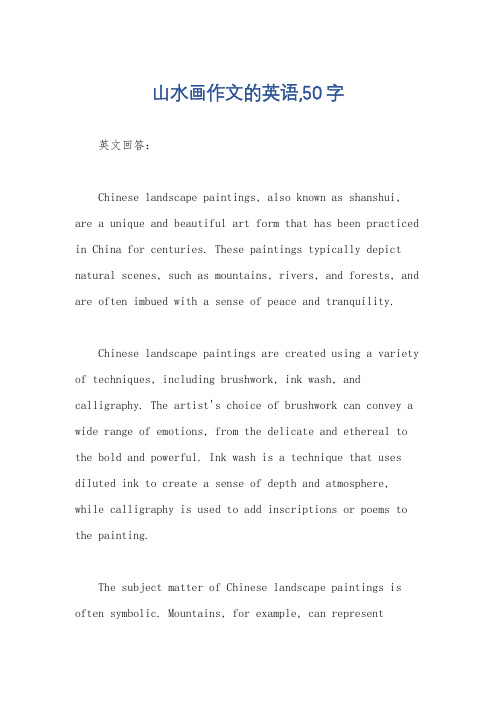
山水画作文的英语,50字英文回答:Chinese landscape paintings, also known as shanshui, are a unique and beautiful art form that has been practiced in China for centuries. These paintings typically depict natural scenes, such as mountains, rivers, and forests, and are often imbued with a sense of peace and tranquility.Chinese landscape paintings are created using a variety of techniques, including brushwork, ink wash, and calligraphy. The artist's choice of brushwork can convey a wide range of emotions, from the delicate and ethereal to the bold and powerful. Ink wash is a technique that uses diluted ink to create a sense of depth and atmosphere, while calligraphy is used to add inscriptions or poems to the painting.The subject matter of Chinese landscape paintings is often symbolic. Mountains, for example, can representstrength and stability, while rivers can represent the flow of life. Forests can symbolize mystery and the unknown, while clouds can represent the passage of time.Chinese landscape paintings are not simply representations of the natural world. They are also expressions of the artist's inner thoughts and feelings. The artist's choice of subject matter, brushwork, and ink wash all contribute to the overall mood and tone of the painting.Chinese landscape paintings are a beautiful and evocative art form that can be enjoyed by people of all cultures. They offer a glimpse into the Chinese worldview and can help us to appreciate the beauty of the natural world.中文回答:山水画,又称中国山水画,是中国特有的一种绘画形式,已有上千年的历史。
学校举办中国山水画展览活动的英语作文
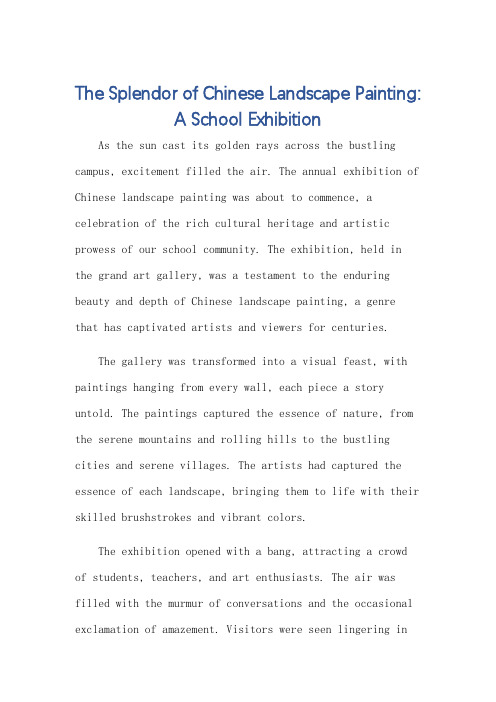
The Splendor of Chinese Landscape Painting:A School ExhibitionAs the sun cast its golden rays across the bustling campus, excitement filled the air. The annual exhibition of Chinese landscape painting was about to commence, a celebration of the rich cultural heritage and artistic prowess of our school community. The exhibition, held in the grand art gallery, was a testament to the enduring beauty and depth of Chinese landscape painting, a genrethat has captivated artists and viewers for centuries.The gallery was transformed into a visual feast, with paintings hanging from every wall, each piece a story untold. The paintings captured the essence of nature, from the serene mountains and rolling hills to the bustling cities and serene villages. The artists had captured the essence of each landscape, bringing them to life with their skilled brushstrokes and vibrant colors.The exhibition opened with a bang, attracting a crowdof students, teachers, and art enthusiasts. The air was filled with the murmur of conversations and the occasional exclamation of amazement. Visitors were seen lingering infront of their favorite paintings, lost in the beauty and tranquility they portrayed.One of the most captivating paintings was a rendering of a mountain village at dusk. The artist had masterfully captured the soft glow of the setting sun, casting a warm hue over the village. The details were meticulous, from the cobblestone streets to the smoke rising from the chimneys of the houses. It was a painting that invoked a sense of nostalgia and warmth, reminding us of the simple beauty of rural life.Another noteworthy piece was a painting of a vast river landscape, with boats floating lazily on the water and mountains looming in the distance. The artist had used a blend of blue and green hues to capture the serenity of the river, while the boats and mountains added a sense of scale and depth to the composition. It was a painting that invoked a sense of tranquility and peace, a perfect escape from the hustle and bustle of daily life.The exhibition also featured a section dedicated to the history and evolution of Chinese landscape painting. Panels displayed information about the different styles andtechniques used by artists over the centuries, from the ancient scroll paintings of the Song dynasty to the contemporary works of modern artists. This section was a testament to the rich history and continuous evolution of Chinese landscape painting, a journey that spanned thousands of years.The exhibition was not just a showcase of artistic talent but also an educational platform. Workshops were conducted by renowned artists, who shared their insights and techniques with the students. These workshops were a great opportunity for the students to learn and understand the intricacies of Chinese landscape painting, and many of them were seen practicing their skills with great enthusiasm.The exhibition concluded with a bang, as the school community gathered for a closing ceremony. Awards were presented to the winning artists, and the exhibition was declared a resounding success. The event not only showcased the artistic prowess of our school community but also served as a reminder of the rich cultural heritage we inherited.The exhibition left a lasting impression on all those who visited. It was a celebration of art, culture, and heritage, a testament to the enduring beauty and depth of Chinese landscape painting. As the gallery doors closed, leaving behind a trail of fascinated faces and inspired minds, one thing was clear: the spirit of Chinese landscape painting had taken root in our school, and it wouldcontinue to flourish and inspire generations to come.**中国山水画展览:校园内的文化盛宴**当阳光洒满忙碌的校园,空气中弥漫着激动与期待。
中国山水画历史英文作文
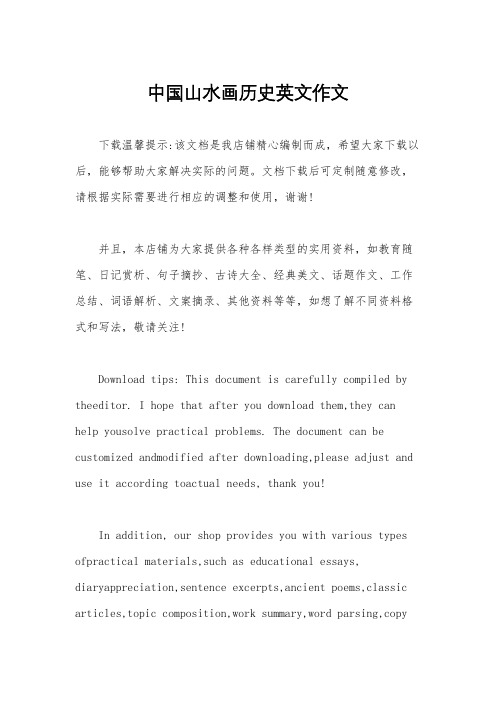
中国山水画历史英文作文下载温馨提示:该文档是我店铺精心编制而成,希望大家下载以后,能够帮助大家解决实际的问题。
文档下载后可定制随意修改,请根据实际需要进行相应的调整和使用,谢谢!并且,本店铺为大家提供各种各样类型的实用资料,如教育随笔、日记赏析、句子摘抄、古诗大全、经典美文、话题作文、工作总结、词语解析、文案摘录、其他资料等等,如想了解不同资料格式和写法,敬请关注!Download tips: This document is carefully compiled by theeditor. I hope that after you download them,they can help yousolve practical problems. The document can be customized andmodified after downloading,please adjust and use it according toactual needs, thank you!In addition, our shop provides you with various types ofpractical materials,such as educational essays, diaryappreciation,sentence excerpts,ancient poems,classic articles,topic composition,work summary,word parsing,copyexcerpts,other materials and so on,want to know different data formats andwriting methods,please pay attention!Chinese landscape painting, also known as shan shui painting, has a long and rich history in Chinese art. It has been a highly respected and admired art form for centuries, and has had a significant influence on the development of Chinese culture.The origins of Chinese landscape painting can be traced back to the 4th century, during the time of the Six Dynasties. It was during this period that the art form began to take shape, drawing inspiration from the natural world and the beauty of the Chinese landscape.One of the key characteristics of Chinese landscape painting is the use of brush and ink to create images that evoke a sense of harmony and tranquility. Artists often use a combination of bold brushstrokes and subtle washes to capture the essence of the natural world, from towering mountains to winding rivers and serene forests.The subject matter of Chinese landscape painting often reflects the artist's deep connection to nature and their spiritual beliefs. Many paintings feature elements such as mountains, water, and trees, which are seen as symbols of strength, resilience, and the passage of time.Throughout its history, Chinese landscape painting has been influenced by various artistic movements and styles, from the meticulous detail of the Song dynasty to the bold and expressive brushwork of the Yuan and Ming dynasties. Each era has brought its own unique perspective and techniques to the art form, contributing to its rich and diverse tradition.Today, Chinese landscape painting continues to be a vibrant and dynamic art form, with contemporary artists drawing on traditional techniques while also pushing the boundaries of the genre. It remains a powerful and evocative means of expressing the beauty and majesty of the natural world, and continues to inspire and captivate audiences around the world.。
英语作文中国山水画的内容
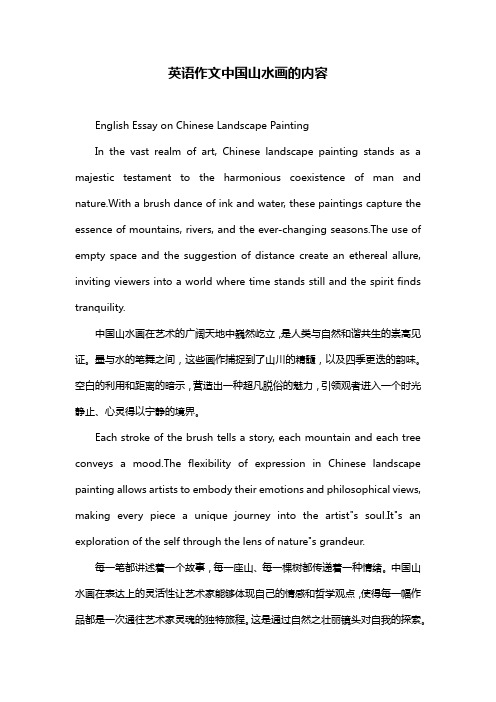
英语作文中国山水画的内容English Essay on Chinese Landscape PaintingIn the vast realm of art, Chinese landscape painting stands as a majestic testament to the harmonious coexistence of man and nature.With a brush dance of ink and water, these paintings capture the essence of mountains, rivers, and the ever-changing seasons.The use of empty space and the suggestion of distance create an ethereal allure, inviting viewers into a world where time stands still and the spirit finds tranquility.中国山水画在艺术的广阔天地中巍然屹立,是人类与自然和谐共生的崇高见证。
墨与水的笔舞之间,这些画作捕捉到了山川的精髓,以及四季更迭的韵味。
空白的利用和距离的暗示,营造出一种超凡脱俗的魅力,引领观者进入一个时光静止、心灵得以宁静的境界。
Each stroke of the brush tells a story, each mountain and each tree conveys a mood.The flexibility of expression in Chinese landscape painting allows artists to embody their emotions and philosophical views, making every piece a unique journey into the artist"s soul.It"s an exploration of the self through the lens of nature"s grandeur.每一笔都讲述着一个故事,每一座山、每一棵树都传递着一种情绪。
- 1、下载文档前请自行甄别文档内容的完整性,平台不提供额外的编辑、内容补充、找答案等附加服务。
- 2、"仅部分预览"的文档,不可在线预览部分如存在完整性等问题,可反馈申请退款(可完整预览的文档不适用该条件!)。
- 3、如文档侵犯您的权益,请联系客服反馈,我们会尽快为您处理(人工客服工作时间:9:00-18:30)。
请在以下的诗句中,选择适合这幅《富春山 居图》的诗。
a.大漠孤烟直,长河落日圆。 b.采菊东篱下,悠然见南山。 c. 山穷水复疑无路 ,柳暗花明又一村
C.欣赏名画体会其意境
《瑞奥道中》 张大千
大千先生此画描绘三面峭壁围绕的峡谷, 有一岩平伸,上面盖了房舍,两位高士徐行对 话,对岸绝壁不见其顶,有一垂瀑下泄直入溪 涧。
而真正高明的是画了在荒芜的山野之间 一个小和尚在溪边挑水。如此一来,就巧妙 的表现了“藏”这一字的意境。
互动题
A.吟诗作画 先看这首大家比较熟悉的诗:
早发白帝城 李白 朝辞白帝彩云间,千里江陵一日还。 两岸猿声啼不住,轻舟已过万重山。 请从下面两幅作品中,选取适合这首诗的画。
B.依画题诗
全画山壁及云气以湿墨为主,辅以轮廓及 峻Hale Waihona Puke ,浑然天成,随心所欲而又有笔有墨。
斧劈皴
米点皴
牛毛皴
披麻皴 荷叶皴
解索皴
乱柴皴
云头皴 雨淋皴
总结 中国山水画把具象与抽象完美 的集合在一起,用有限的画幅来传 达一种真实的空间境象。“言有境 而意无穷”,总之山水画的意境在 人们的无尽想象之中。 经过了这节课的学习,希望以 后去旅行的各位同学,仔细观赏你 身边的山山水水。
山川美景 诗情画意 ——中国山水画欣赏
中国画的种类分为几种呢? 花鸟、山水、人物
山水画是中国画中的大门类,但大家知道, 为什么古人这么爱表现山水吗?
中国人对山水有着宗教一样的崇拜与敬 畏,一切神灵皆隐于山水之中,山高水远, 山静水动,蕴涵着天体宇宙无限奥妙,很多 文人都留下了独到的山水观念。
如果说桂林是一个旅游发展的生命体, 那么漓江可以说绝对是桂林旅游的灵魂
游览漓江,有一个绝妙之处,就是不愁 天气变化,因为不同天气漓江景色有不同特 点:晴天,看青峰倒影;阴天,看漫山云雾; 雨天,看漓江烟雨。甚至是阴雨天,但见江 上烟波浩渺,群山若隐若现,浮云穿行于奇 峰之间,雨幕似轻纱笼罩江山之上,活像一 幅幅千姿百态的泼墨水彩画。正是“桂林山 水甲天下,绝妙漓江泛秋图”。
溪 山 行 旅 图
范 宽
玉堂尽掩春日闲, 中有郭熙画春山。 鸣鸠乳燕动睡起, 白波青峰非人间。
早春图 郭熙
寒江独钓图 马远
山关 溪山 待行 渡旅 图图
关关 仝仝
匡 庐 图
荆 浩
山 水 图 册 之 一
王 时 敏
富春山居图 日出·印象
游春图 展子虔
王希孟的《千里江山图》,气势 更为宏大。展示了祖国锦绣山河 的神奇美丽。全图长12米,画面 视野开阔,境界幽深,色调爽秀 明快。展卷观赏,路转峰回,美 不胜收,令人有壮游千里之感。
• 五代两宋达到高度成熟, • 元代以后,水墨山水、浅绛山水代兴。 • 欣赏(多媒体) • 东晋 顾恺之 《洛神赋图》绢本设色 • 展子虔《游春图》 • 展子虔是隋代最杰出的画家之一,善画人物、车马、台
阁,尤工山水。唐宋人称先赞展子虔画山川远近之势,
“有咫尺千里之势”,展子虔在山水上的成就,后来直
接影响到唐代的李思训、李昭道父子,故在山水画史上 具有特别的意义。
山水画可分为:
工笔山水——青绿山水、金碧山水
写意山水——浅绛山水、水墨山水、 泼墨山水
中国古代山水画
• 南北朝时期人:人们对于自然美的认识和欣赏,促成文 学创作中的山水诗和绘画创作中的山水画的兴起
• 隋唐:山水画脱离了人物画,成为独立的画种。在这之 前山水画主要是作为人物画的背景出现的。
构图不受自然真实景物的局限,可以进行 大胆的取舍和创造。
2、三远法、散点透视法
中国画在描绘自然的同时,更注重展示 画家的内心世界,所以他们笔下的自然就因 人而异地发生了各种变化,以达到天人合一 的境界。比如:三远(深远、高远、平远)。 中国人认为:"目有所极,故所见不周"。所 以采取了视点运动的“三远”表现法。这种 表现法就让我们在看一幅画的时候随着画家 的视角边走边看,形成一种动态的意像。所 以中国画的画幅,若不是条幅立轴就是横卷。 总之是追求一个“远”字,打破了时间和空 间的限制。
山水画家们常常也是游览名山大川的旅 行家,清代大画家石涛就提出了“搜尽奇峰 打草稿”的名句。
李可染作品《漓江雨中泛舟图》
李可染作品《漓江揽胜图》
李可染的水墨画以“黑”、“满”、 “崛”、“涩”来概括其艺术内涵,无疑地, 李可染为水墨画世界开创出新的格局。他的 画面结构,以一种范宽式的饱满构图,山势 迎面而来,瀑布浓缩为一条白色的裂隙,用 沉涩的笔调一寸一寸地刻划出来,绵绵密密 地深入到画面的每一个角落,在一张纸上, 表现出最大最丰富的内容。
3、意境美
中国画中追求的“诗中有画”,“画中有诗”, 意境美是从古至今一脉相承的,说起这意境之美, 有这么一个故事:在宋代,画家在进入画院之前, 需要经过考试,只有考试合格的画家才能成为翰林 图画院的成员。而考试的方法也很特别,就是由宫 廷主考人在古诗中寻找一句现成诗句,作为考试的 题目,应考的画家们便要发挥自己的想象,将文字 的诗句变成可视的图画。有一年,皇帝宋徽宗赵佶 取了这么一个题目:乱山藏古寺。大家现在可以静 静地思考:如果是你在考试,你会如何表现呢?有 人画乱山之中露出一个塔尖;也有人画古寺的一角。
画家笔下描绘的都是我们刚才一起见过的 漓江山水风光,为什么我们看完以后会有似 曾相识,却又不知所画何处的感觉呢?让我 们来揭开这个迷团 。
风景照片:纪录自然
国画山水:表现意境 (画家心中的风景)
1、构思构图
山水画的构图就是古人所说的“经营位 置”。构图安排有近景、中景、远景之分, 要突出画面的主体结构,使画面众多形象中 有主有次,有虚有实,有浓有淡。
